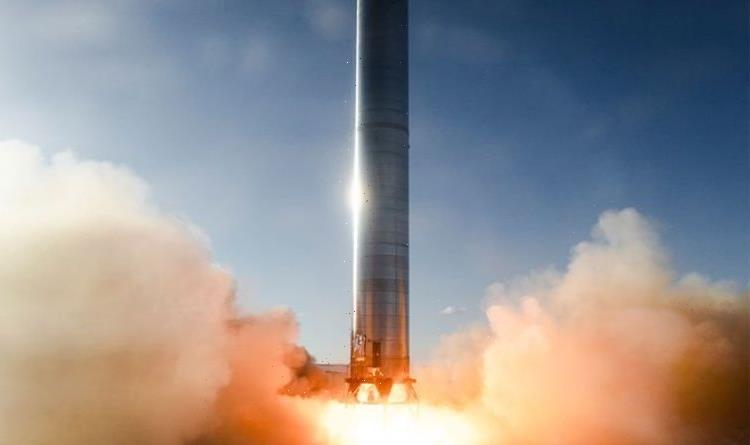Elon Musk discusses future of SpaceX's Starship system
We use your sign-up to provide content in ways you’ve consented to and to improve our understanding of you. This may include adverts from us and 3rd parties based on our understanding. You can unsubscribe at any time. More info
The SpaceX rocket came to life in South Texas late on Monday (local time) at the company’s base of operations in Boca Chica. Although brief, the static fire test engulfed the base of the rocket in smoke and flames. Super Heavy is the reusable workhorse behind SpaceX’s Mars-bound Starship spacecraft.
The first-stage booster will be used to launch Starship out of Earth’s atmosphere and towards the Moon, Mars and possibly beyond.
Monday’s test marked the very first time SpaceX fans had a chance to see the stainless steel colossus in action.
During a static fire, the rocket briefly fires its engines at full throttle but remains firmly planted to the ground.
SpaceX is aiming to launch Super Heavy and Starship on their first orbital flight later this year and static fire tests are part of the critical pre-flight testing.
This particular model has been dubbed Booster 3 and is but one in a production line of prototypes awaiting testing.
Elon Musk, the mastermind behind SpaceX, confirmed on Twitter the test went according to plan and hinted at more tests around the corner.
The South African billionaire tweeted: “Full test duration fo three Raptors on Super Heavy Booster!”
He was then quizzed by his loyal fans about the possibility of Booster 4 rolling out to the Boca Chica launchpad – or as Mr Musk calls it, Starbase.
The tech mogul replied: “Depending on progress with Booster 4, we might try a nine engine firing on Booster 3.”
Once completed, Super Heavy will be the most powerful launch vehicle ever developed by the California-based company.
Starship’s first stage is expected to be equipped with more than 30 of the company’s signature Raptor engines.


For comparison, the Falcon Heavy – the combined might of three Falcon 9 rockets – only boasts 27 engines.
Super Heavy will have the power to propel humans and cargo into orbit, at which point the Starship spacecraft will take over.
SpaceX boasts on its website: “SpaceX’s Starship spacecraft and Super Heavy rocket (collectively referred to as Starship) represent a fully reusable transportation system designed to carry both crew and cargo to Earth orbit, the Moon, Mars and beyond.
“Starship will be the world’s most powerful launch vehicle ever developed, with the ability to carry in excess of 100 metric tonnes to Earth orbit.”
The Super Heavy booster stands tall at 230ft (70m) and has a gross liftoff mass of more than 6.6 million pounds.


The rocket is powered by a mix of chilled liquid oxygen and liquid methane to escape the clutches of Earth’s gravity.
After separating from Starship after launch, each booster will return to Earth for a soft touchdown.
Originally, SpaceX envisioned landing the rocket on its six sturdy legs.
However, being the visionary that he is, Mr Musk has proposed catching the booster with its launch towers instead.
The bizarre plan would see the rocket plunge into the atmosphere towards its launch platform before being gently intercepted mid-air.
Mr Musk tweeted earlier this year: “We’re going to catch the Super Heavy Booster with the launch tower arm, using the grid fins to take the load.”
According to the billionaire, this would be a purely cost-cutting endeavour as it would save on mass and the need to install landing legs.
Towards this goal, SpaceX has purchased a number of off-shore drilling platforms to launch and land the rockets out in the ocean.
Paired with the 160ft (50m) tall Starship, the whole system will stand tall at nearly 400ft (120m).
Source: Read Full Article
